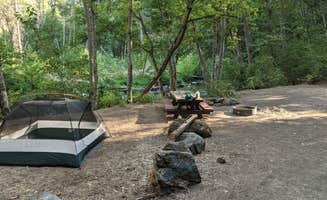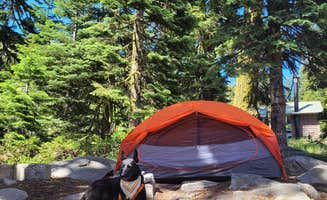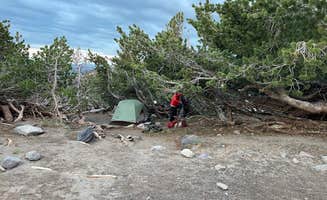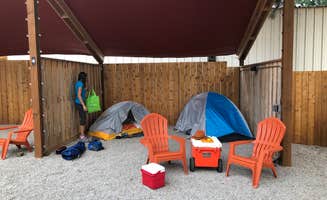Tent camping near Yreka offers sites at elevations ranging from 2,500 to 7,000 feet throughout the Klamath National Forest and nearby mountain ranges. Summer temperatures typically range from 45°F at night to 85°F during day at higher elevations, with significant cooling after sunset even during July and August. Most dispersed sites require campers to travel at least 15-30 minutes from main highways on forest roads.
What to do
Swimming in alpine lakes: Castle Lake Dispersed Camping provides easy access to cool mountain water during summer months. One camper noted, "If you camp here check out Siskiyou Lake right down the way to swim it was THE best view of Shasta and the most mellow and perfect swimming conditions!" Most swimming areas lack lifeguards or designated beaches, so bring water shoes for rocky entries.
Mountain biking trails: Mount Ashland Campground offers direct access to multiple trail systems. A visitor shared, "Pit toilets. No water. Hiking. Mountain biking. Watch out for the chipmunks. Free." The Pacific Crest Trail passes nearby, making this area popular with both day riders and through-hikers.
Fishing for trout: Nearby lakes stock rainbow trout throughout summer. According to one Applegate Lake visitor, "Weather was perfect and the lake water level was great. It's got a great beach area for kids to swim and play. Full of huge trout." California fishing licenses required for most water bodies near Yreka, with some lakes having catch limits.
What campers like
Mountain views: The panoramic vistas of Mount Shasta dominate the landscape from many camping areas. At Castle Lake Dispersed Camping, campers appreciate the natural scenery: "Road dips down but rutted and I'm low clearance so can't tell what's down there. I'm in the only pullout off the side of the road before it dips. Awesome view."
Creek access: Many camping areas feature running water access for cooling off. One camper at Beaver Creek Campground mentioned: "Nice river running right next to the camp to cool off in and a wading pool has been made. Close to the road but little or no traffic." Creeks typically flow strongest in June and gradually diminish through September.
Solitude at primitive sites: Toad Lake Campground provides a remote experience for those willing to make the journey: "Toad Lake is a pristine mountain lake accessible only via a long, rough, and rocky single lane dirt road... A short 15 minute hike takes you to the lake, where there is 2 picnic tables and a fire pit." Most primitive sites lack formal boundaries, allowing campers to spread out.
What you should know
Limited water sources: Most tent camping sites require bringing your own supply. At Martins Dairy Campground, facilities are minimal but functional: "They offer day use, horse use, and overnight use. The overnight use has 6 available spots at $10/day which is a deal given that the sites are ample with awesome picnic benches and fire pits."
Rough access roads: Many campsites require driving on unpaved forest roads. A Castle Lake visitor warned: "About 15 min off the I-5 and climbing most of the way. High and dry. Great view of Shasta Mtn. 8 or more still available for higher clearance vehicle."
Weather variability: Temperature swings of 30-40°F between day and night are common. One Mount Ashland camper noted: "The sunsets are GORGEOUS and stargazing is amazing but it is WINDY and I mean, drops 20 degrees windy, rocks the van windy." Pack warm sleeping bags even for summer camping.
Tips for camping with families
Swimming holes: Applegate Lake offers safe water access with gradual entry points: "It's got a great beach area for kids to swim and play." The lake maintains relatively consistent water levels throughout summer, unlike some smaller water bodies that diminish by August.
Playground access: Etna City Park combines basic tent camping with town amenities: "It's a rather small park. Tent camping is ok. There's a playground and restrooms... We didn't use it but heard there is a community pool for free public use."
Small lake exploration: Squaw Lakes provides a manageable size for younger children: "This is truly an Oregon gem. Swimming, non-motorized boating, fishing, hiking, trail cycling, you name it, this place has it." Rental boats are sometimes available from campground hosts during peak season.
Tips from RVers
Leveling challenges: Many tent sites near Yreka work poorly for larger vehicles. One Mount Ashland visitor explained: "This campground is really only set up for tent campers. The place to park for vehicles is far from level. Even with camper jacks I was sleeping at an angle."
Pull-offs for small rigs: LOGE Mt Shasta offers designated spots for smaller vehicles: "We parked our rented Cabana van of 19'8" back-in to the wooden cubicles and therefore had a reasonably private space with 2 Adirondack chairs and a picnic table." Most forest service sites limit vehicle size to under 22 feet.
Limited turnaround space: Forest roads often lack adequate turnaround areas for larger vehicles. A Castle Lake camper advised: "I would probably not recommend with a trailer. I made it down with my Tacoma and a 12ft travel trailer but it was a stretch. Super easy to get in, but took a long time to turn around and get back out. Anything bigger than and you're probably stuck."






